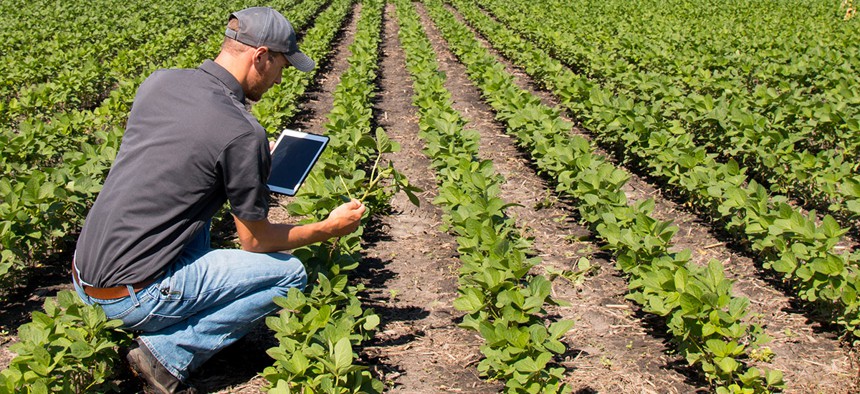sponsor content What's this?
Agriculture Department Uses Hybrid IT Model to Speed Field Data Processing

Presented by
FedTech

The USDA’s National Agricultural Statistics Service has embraced hybrid IT but is focused less on the technology and more on how it can help farmers and internal stakeholders.
The Agriculture Department is vast, with about 100,000 employees and 17 component agencies, making it a behemoth in the federal IT community. Yet one of those component agencies, the National Agricultural Statistics Service (NASS), aims to stay nimble by using a hybrid IT approach.
NASS conducts thousands of surveys and publishes more than 400 reports every year, including commodities futures reports on important crops like corn, cotton and soybeans, according to NASS CTO Michael Valivullah. Hybrid IT gives agencies and other organizations the benefits of both off-premises public cloud and on-premises private cloud.
NASS strives to use hybrid IT to increase its data center capacity and help both internal stakeholders and external customers, such as farmers, Valivullah told FedScoop. Hybrid IT allows NASS to quickly add capacity when needed and could allow the agency to take advantage of emerging technologies like the Internet of Things and virtual reality.
“We would like to look at hybrid IT in a way that actually adds value, not just for the sake of new technology,” he says.
Hybrid IT Gives USDA Flexibility
The hybrid IT model increases agility and capacity, and also boosts efficiency at NASS, Valivullah says. It has made it much easier for the agency to add virtualized servers, for example.
“We call it ACE,” he says. “Agility is No. 1 because in olden days, for a server to be spun up, it took us two weeks. Now, we can do it within hours.” Shifting to the cloud and embracing virtualization has helped enhance NASS’ agility, he says.
NASS has legacy IT systems running in the background that it must continue to support, Valivullah says, but the agency also needs to “create new avenues to take advantage of the new technology to add more value” to users and the broader public.
NASS wants to enhance the use of precision agriculture, which relies on satellite technology to observe, measure and respond to variability in crops in the field, according to Valivullah. Moving forward, he says, the agency also wants to use data from connected combines and field sensors for climate, moisture and other variables.
“Our idea is not to ask the farmers for the information if that information is available and mission-readable,” Valivullah says. “We will be able to gather that information and reduce the burden on the farmer, and also it will decrease the number of errors that manual processes provide.”
USDA can process and analyze all of that data more efficiently by spinning up virtual servers. Valivullah says NASS can automate data processing, including from IoT devices, and then will be in a position to “dial up” analytical tools and computational models to deliver predictive analytics on crops. The technology, he says will “make it more useful for to the clients and customers, our internal customers and external customers.”
USDA Wants to Ride the Evolving Technology Wave
Technology is constantly changing, Valivullah notes, pointing out that the federal government has evolved from mainframe computers to the client/server model and virtualization, and is now embracing cloud, IoT and emerging technologies like virtual reality.
“These technologies are going to enable us to provide very rich and context-sensitive information, and it is going to make life a lot easier for the users as well the citizens and the internal customers,” he says.
“In the future, we may be able to have something called cognitive competence,” Valivullah adds. “Based on the user’s need, we may be able to provide information before they ask for it.”
A NASS official in the future could use VR to be in the field with a farmer and validate their assessments on crop growth in real time, he adds. “There are so many opportunities that are available, and hopefully in the near future we may be able to implement those things and take advantage of it,” he says. “But I don’t think we will be evolving out of bimodal agriculture.”
NASS and USDA will not discard the bimodal hybrid IT model, he says, because there will always be new technologies to incorporate into the larger IT environment, according to Valivullah. “We will constantly be growing, and once you think you are going to reach the goal post, then the goal post is going to move, because some other new technology will come and take over and ask you to do more — better, faster, quicker,” he says. “So I think it is going to be a continuous transition toward digital transformation. And I don’t see an end.”
This content is made possible by FedTech. The editorial staff of Nextgov was not involved in its preparation.


